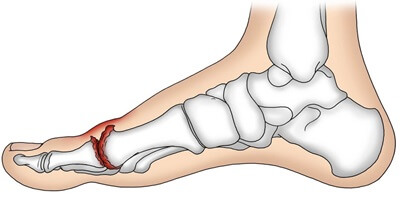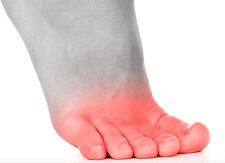- Home
- Diagnosis Guide
- Foot Lumps
- Lump on Toe
Lump On Toe
Written By: Chloe Wilson BSc(Hons) Physiotherapy
Reviewed By: FPE Medical Review Board
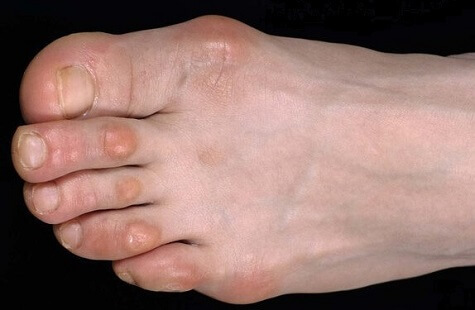
A lump on the toe is a common problem that can affect people of all ages.
There are lots of different types of toe bumps and lumps. There may be a big lump on the toe or a small one, a hard lump under the toe or a soft lump on top.
Toe lumps may be caused by a problem in one of the bones, excess fluid, a benign growth or inflammation from friction or pressure.
In most cases, a lump on the toe is nothing serious and there are lots of things you can do to treat foot and toe lumps at home.
Here we are going to look at the common causes of toe bumps and lumps and how to work out which one you have. We will then go on to look at how to treat them and the best ways to get rid of the lump on your toe and stop it from coming back again.
If you are more bothered by pain than the lump on your toe, check out the Toe Pain Causes & Treatment article
Causes Of Toe Lumps & Bumps
A lump on the toe may develop in the:
- Toe Joint: deformities or injuries to one or more of the toe joints can result in a lump on the toe e.g. fracture or hammer toe
- Skin: excess fluid, infection or friction can build up leading to a soft lump on the toe e.g. corns or cysts
- Nerve: nodules can form in the nerves running between the toes resulting in a hard lump under the toe e.g. Morton’s neuroma
There are also a few medical conditions that can cause a big lump on the toe to form, such as gout.
Each of these toe lumps will present slightly differently and require specific treatment. So let’s start by looking at the eight most common causes of a lump on the toe.
1. Bunions
The most common cause of a hard, big lump on the toe is bunions. Bunions are caused by one of the toe bones shifting out of place.
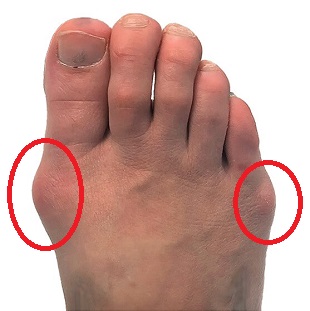
Bunions can occur in two places:
- Big Toe: aka Hallux Valgus. The tip of the big toe shifts inwards towards the second toe as the base of the big toe pushes outwards, causing a hard lump on big toe. In some cases, the big toe starts to cross on top or underneath the second toe. The big toe is the most common site for bunions
- Little Toe: aka Tailor’s Bunion or bunionette. The tip of the little toe shifts inwards towards the fourth toe as the base of the little toe pushes outwards causing a lump on the side of the little toe. Bunionettes are much less common than bunions
The further over the toe shifts, the larger the lump on the toe becomes to the point where it may start rubbing on your shoe and causing discomfort. The most common cause of bunion lumps on toes is wearing tight footwear, particularly pointed, high heel shoes.
A bunion lump on the toe is typically:
- Hard: lump on side of toe around the joint
- Red: if there is inflammation from the bunion rubbing on your shoes
- Painful: increasing pain as the toe deviates further
- Stiff: toe movement often becomes increasingly limited as the bunion increases in size
- Slow Growing: a bunion lump on toe tends to gradually get bigger and bigger over months/years rather than days/weeks
There are a number of things you can to do treat bunions and help stop the lump on your toe getting bigger and bigger – find out more about the causes, symptoms and best treatment options in the Foot Bunions Section.
2. Hallux Rigidus
Hallux rigidus is a common cause of lumps on top of the big toe.
With hallux rigidus, there is wear and tear at the joint between the big toe and the forefoot which can result in inflammation and excess bone growth.
Bone spurs may develop forming hard lumps, usually on the top of the big toe.
The most common symptom of hallux rigidus is stiffness and pain in the big toe which can make daily activities such as walking and climbing stairs difficult.
Find out all about the common causes, symptoms, diagnosis and best treatment options in the Hallux Rigidus section.
3. Corns & Calluses
Another common cause of a lump on the toe is corns and calluses, typically caused by repetitive friction or pressure from ill-fitting shoes. They each cause slightly different types of lumps on toes:
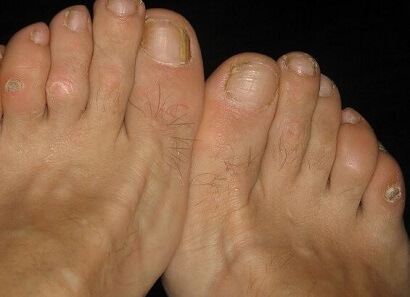
- Corns: are usually small, pale, yellow areas of hard, raised skin that can cause discomfort. A corn lump on the toe tends to be round and located on the toe joint or in between toes
- Calluses: are larger areas of thickened, hardened skin that are typically painless. Callus toe lumps are generally more flat and may appear anywhere on the foot
Different methods of treatment are available for corns and calluses, such as creams, chemicals, pumice stones, and medications.
If you think these sound like the cause of the lump on your toe, check out the Foot Corns & Calluses section.
4. Digital Mucous Cyst
The most common cause of a small, soft lump on the toe is a digital mucous cyst, aka toe ganglion.
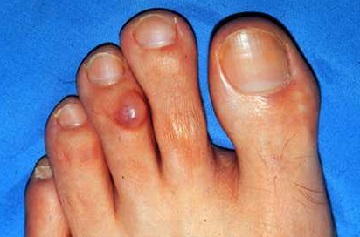
Digital mucous cysts are small fluid-filled sacs that occur when the sheaths around the joint or tendon of your toe are disrupted.
This could be due to arthritis, injury or wearing shoes that don't fit properly. In some cases, a ganglion lump on the toe may just occur without an obvious cause.
A digital mucous cyst lump on the toe isn’t usually painful, but it can become infected if it gets irritated or bursts. A lump on the toe from a digital mucous cyst is usually:
- Small & Smooth: up to 1cm diameter & slow growing
- Firm: or rubbery in texture
- Round: or oval shaped and domed
- Slightly See-Through: a skin coloured, semi-translucent lump on toe
- Tender: to touch, but not usually painful unless they rub on your shoes
Treatment for a mucous cyst lump on toe typically involves draining and cleaning the cyst, avoiding activities or footwear that could cause further irritation, and sometimes antibiotics or steroid injections. In some cases, the toe lump may be removed with lasers, infrared radiation or surgery.
You can find out all about the causes, symptoms, diagnosis and treatment of this type of lump on toe in the Digital Mucous Cyst section.
5. Hammer, Claw, Mallet Toes
A hard lump on the toe may also be caused by hammer, mallet and claw toes, types of toe deformity where the joint becomes bent and the toe curls up. The shape of the lump on the toe will depend on which toe joints are affected:
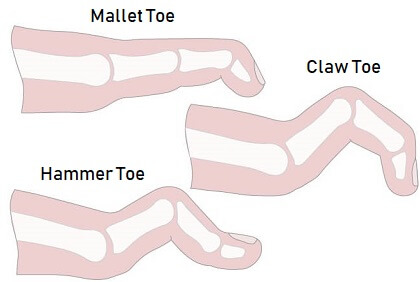
- Mallet Toes: have the end joint bent downward and the tip pointing up
- Claw Toes: both the middle and end joints bend downward and the tip of the toe points up
- Hammer Toes: have the same shape as a hammer, with the middle joint bent downward and the tip pointing up
These toe lump deformities usually occur due to wearing ill-fitting shoes, arthritis, altered foot biomechanics or trauma to the toe.
If the lump on the toe from these deformities gets large enough, it can cause real problems and may require surgery, but in most cases, they can be treated at home with a combination of orthotics, exercises and toe straps.
You can find out all about the causes, symptoms and treatment options of these toe lumps in the Hammer, Claw & Mallet Toe sections.
6. Gout Foot
Gout foot can cause lumps to form on the toes, as well as swelling, redness, and pain in the affected area. Symptoms normally come on very quickly, often at night, and can be very intense. Gout foot typically causes a large lump on the big toe but can affect the other toes as well.
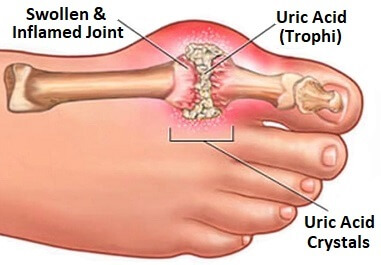
Gout is caused by an accumulation of crystalized uric acid in the joints, leading to inflammation.
High levels of uric acid can be caused by diets high in purines, certain medical conditions, obesity, or alcohol consumption. Purines are typically found in foods such as red meat, shellfish, and sugar-sweetened beverages.
Treating gout involves reducing the amount of uric acid in the body through medications and lifestyle changes. Medications may include non-steroidal anti-inflammatory drugs, colchicine, steroids, or medications that target the uric acid directly. Lifestyle changes include avoiding foods high in purines, maintaining a healthy weight, and limiting alcohol intake.
Recurrent episodes of gout are common and if large numbers of urate crystals accumulate, they may form lumps on the toe known as tophi, alongside the usual swelling associated with gout.
You can find all about the causes, symptoms, diagnosis and treatment of gout lump on toe and how to prevent them in the Foot Gout section.
7. Morton’s Neuroma
The most common cause of a hard lump under the toe is a Morton’s neuroma.
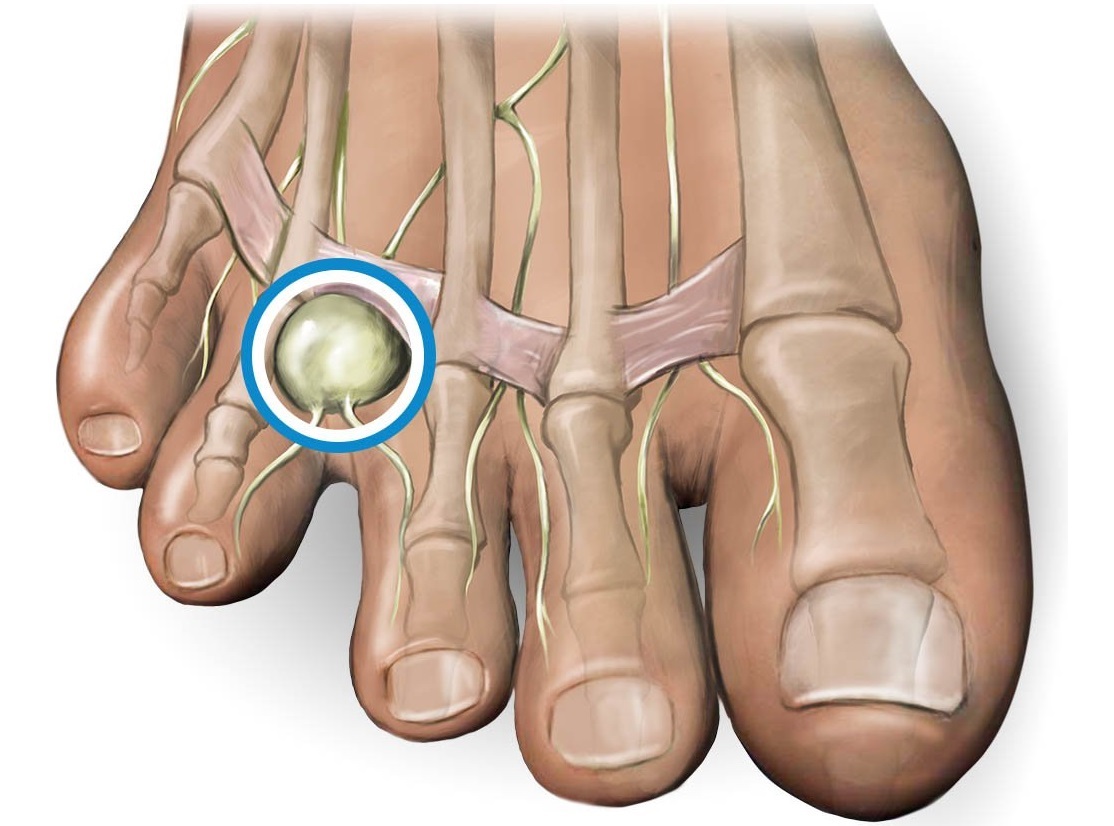
Toe lumps from Morton's neuroma occur when one of the nerves between your toes becomes inflamed, resulting in sharp pain and a feeling of numbness or burning.
A Morton’s neuroma lump under your toe is typically small and flesh coloured, but they may become larger if left untreated.
People often describe the lump under their toe as feeling like they have a small stone stuck in their shoe underneath their foot.
A Morton’s neuroma forms when the nerve is squashed, trapped or stretched or doesn’t have a good enough blood flow. Swelling develops in the nerve and a neuroma may grow around the nerve, causing a hard lump under the toe.
A Morton’s neuroma toe lump is typically caused by wearing shoes that are too tight or putting too much pressure on the feet e.g. high impact sports such as running.
Toe lumps from a Morton’s neuroma typically affect people aged 40-60 and are much more common in women than men.
A Morton’s neuroma won’t go away on its own and treatment aims to reduce the pressure on the toe lump through a combination of footwear, medication, steroid injections and activity modification. In some cases, your doctor may advise surgery to remove the neuroma lump under the foot.
Find out all about how to treat this type of lump under the foot in the Morton’s Neuroma section.
8. Blisters
Blisters are another very common cause of lumps on toes. There are various different types of foot blister that present with different looking foot and toe lumps:
- Friction Blisters: caused by footwear rubbing on the skin causing fluid to build-up just underneath the skin. Friction blisters are usually due to sudden, brief and intense bouts of friction, particularly when wearing new or ill-fitting shoes. A friction blister lump on toe can range from pinprick size to 3 or more centimetres in diameter.
- Cold Blisters: In extreme cold, blood vessels contract pushing blood away from the feet in an attempt to keep us warm. This can lead to blistering and a fluid-filled lump on toe
- Heat Blisters: when exposed to intense heat, blisters can form on the skin
- Medical Condition Blisters: Some medical conditions can cause blister lumps on the toes e.g. chicken pox, athlete’s foot or certain types of eczema which may result in lumps on the toes or a foot rash
- Chemical Blisters: if the skin is exposed to certain chemicals, then blistering may occur with a build-up of fluid that may form a lump on the toes
You can find out lots more about blister lumps on toes and feet and how best to treat them in the Foot Blisters section
9. Foot Rashes
Some foot rashes can result in lumps on the toes and feet. There may be anything from a small fluid-filled lump on one toe to a widespread area of irritation.
- Fungal Infections: e.g. athlete’s foot. Typically presents with scaly, flaky skin but blister lumps may appear on the toes
- Bacterial Infections: e.g. cellulitis. The skin typically appears red and swollen, may become pitted (resembling orange peel) or blister forming lumps on the toes
- Contact Dermatitis: due to an allergic reaction. Often presents a small bumps of spots on the feet which may blister and form lumps on toes
If you want to find out more about the link between a lump on the toe and the different types of foot rashes, including information on the causes, symptoms, diagnosis and treatment options, visit the Foot Rash section.
10. Sesamoiditis
A lump underneath the base of the big toe is usually caused by sesamoiditis. Sesamoiditis develops when there is inflammation of the two pea-sized bones that sit underneath the big toe and the surrounding tendon.
Excess pressure and overuse cause swelling, inflammation and tenderness which can make it painful to take any weight through the toe and can make wearing shoes uncomfortable.
If you want to find out more about this common cause of a lump underneath the big toe, including causes, symptoms and treatment, visit the foot sesamoiditis section.
Other Possible Causes Of Toe Bumps
There are a few other less common causes of lumps on the toe:
- Fractures: a break in one of the toe bones can lead to deformity if the bone shifts out of place e.g. stress fractures
- Lipoma: soft fatty lumps that form just underneath the skin – can occur anywhere in the foot
- Bone Spurs: excess bone is laid down causing a hard lump on the toe. Bone spurs are more common around the heel than in the toes and are often linked with arthritis
- Ganglion Cyst: small round or oval shaped squashy lump filled with thick jelly-like fluid. Ganglion cysts are more common on top of the foot but can occur around the toes
- Plantar Warts: skin infection causing small, rough growths often containing tiny black dots. Verrucas are common in-between or underneath toes
- Hand, Foot & Mouth: a viral infection, common in children that causes itchy red bumps on the toes and bottom of the feet
- Cancer Lump On Toe: most toe lumps are completely benign i.e. non-cancerous but any new lump on your toe should be looked at by your doctor. A cancer lump on the toe tends to be fast growing, irregularly shaped, non-mobile and increasingly painful
You may also be interested in the following articles:
- Lump On Top Of Foot
- Lump On Side Of Foot
- Lump On Bottom Of Foot
- Lump On Heel Of Foot
- Foot Swelling Treatment
- Toe Pain Causes & Treatment
Lump On Toe Summary
There are lots of possible causes of a lump on the toe:
A lump on the big toe is typically caused by bunions, hallux rigidus or gout
A hard lump under the toe is usually from a Morton’s Neuroma, bone spur or sesamoiditis
A soft lump on the toe may be caused by a digital cyst, ganglion cyst, blisters, plantar warts or a foot rash
A red bump on toe may be caused by gout (associated with intense pain), bunions (associated with toe deviation) or a viral or bacterial infection
A lump on the toe associated with some kind of deformity in the toe position may be due to Hammer Toe, Mallet Toe, Claw Toe, Bunions or a fracture
A toe lump on or just under the skin may be from corns, calluses, a mucous cyst, ganglion cyst, blisters, plantar warts, athlete's foot or a foot rash
A big lump on the toe associated with intense pain and redness is usually from gout foot
Related Articles
Page Last Updated: 21st January, 2025
Next Review Due: 21st January, 2027
